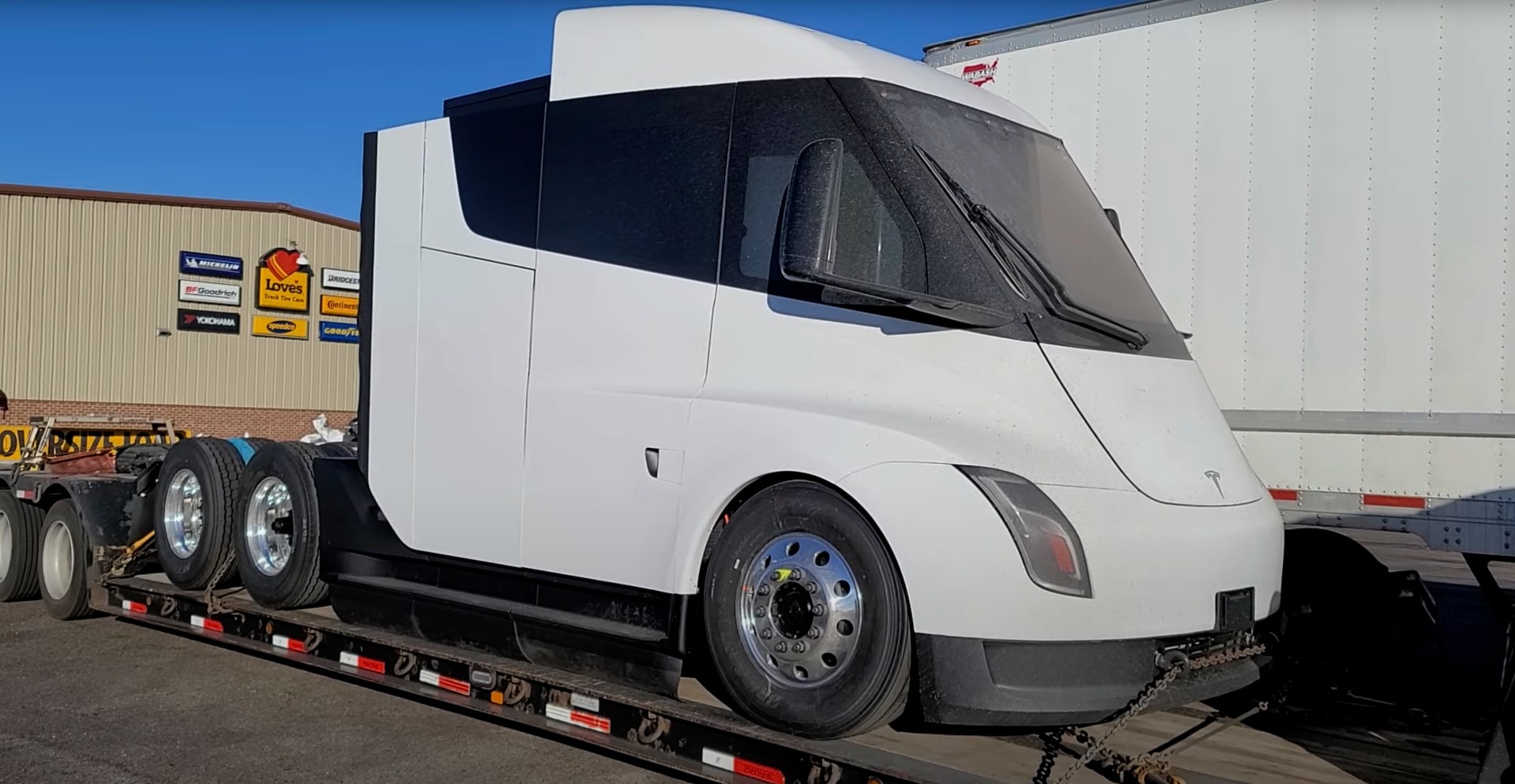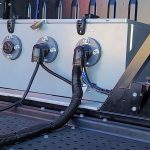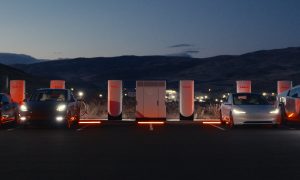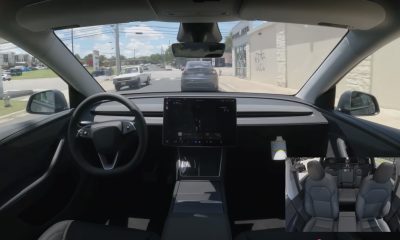

News
Tesla Semi production rumors swirl as frequent sightings up the ante on expectations
Rumors surrounding the Tesla Semi are plentiful in this day and age, especially as sightings of the company’s commercial vehicle are becoming more frequent. Expectations for the new Semi are high already, and Tesla aims to deliver the truck in a timely fashion after several delays.
The new Semi has been spotted numerous times over the past week, hinting toward ongoing testing before Tesla starts volume production of the massive, all-electric commercial vehicle. Less than two weeks after Tesla’s Q4 2020 Earnings Call, where CEO Elon Musk and others detailed the ongoing offensive to develop the vehicle, the Semi is being spotted by people on public roads. Although Musk stated battery constraint is the hold-up in the Semi’s production, it isn’t stopping the company from testing several new truck builds.
Speculation regarding when Tesla will finally begin volume production is growing, and more rumors surrounding the initial deliveries to pre-orderers appear on what seems like a daily basis. However, the big bottleneck is batteries, and Tesla plans to combat this issue with wide-scale cell production and purchasing. The real question is, how many cells will be “enough?”
EXCLUSIVE: For a few weeks I’ve been in contact with a source from a U.S Tesla supplier. They supply certain parts for the S,X,3 and Y, but I’m here to reveal some info on Tesla Semi. As always, take these kinds of things with a grain of salt. Things/timelines can change.
1/6
— Sawyer Merritt ?? (@SawyerMerritt) February 4, 2021
Elon Musk’s Earnings Call Comments
Musk, who stated last year that it was time for Tesla to enter volume production of the Semi, had a different tune during the Q4 2020 Earnings Call on January 27th. Battery cell constraint is a major bottleneck in starting the Semi production, as fulfilling the number of orders it has would likely inhibit Tesla from being able to produce its mass-market passenger vehicles, like the Model 3 and Model Y.
Tesla has recently started producing its own battery cells at a plant that sits adjacent to its main production facility in Fremont, California. Known as the “Kato Road Facility,” Tesla is building its new 4680 cells there, a battery that Tesla claims will cut the cost of its vehicles massively, putting it on a crash course to reach price parity with gas-powered vehicles. The Semi will require significantly more cells than any other Tesla vehicle to date, a problem that the company is aiming to solve by producing its own cells and buying additional ones from third-party suppliers like Panasonic.
Tesla’s 4680 Kato Rd. facility has a top 10 capacity, and it’s not even close to finished
During the Earnings Call, Musk said:
“Prototypes are easy. Scaling production is very hard. So a big part of the reason — the main reason we have not accelerated new products is — like, for example, Tesla Semi is that we simply don’t happen our cells group. We — this — if we were to make the Semi like right now, which we could easily go into production with the Semi, but we would not have enough to cells built for it right now. We will have cells group in ourselves for Semi when we are producing the 4680 volume. But for example, Semi would use typically five times the number of cells that a car would use, but it would not sell for five times what a car would sell for. So it kind of doesn’t make — it would not make sense for us to do the Semi right now, but it will absolutely make sense for us to do it as soon as we can address the cell production constraint. The same would go for that.”
Effectively, Musk explained that it makes more fiscal sense to focus on the mass-market consumer products for right now. When the Kato Rd. Facility begins a massive production of the 4680 cells, Tesla can begin the Semi production efforts, but that doesn’t mean prototypes aren’t on the road now.
New Sightings
Following a sighting by The Kilowatts last week, two new sightings of the Semi have surfaced of the all-white Tesla commercial vehicle.
New Tesla Semi with updated windows, door handles, and tail lights spotted in Sacramento
One video from Cory Draper on YouTube shows a four-and-a-half-minute-long walk around of the Semi, getting a close-up look at the vehicle. One of the most striking features is the size of the power cell, as Draper estimates it is between four and five feet in length. A massive truck requires a massive power source, and the Semi’s sizeable battery storage compartment will drive the truck’s 300 or 500-mile range. Another video from Ivaylo Tzintzarsky shows the power cell from the opposite side.
- YouTube: Cory Draper
- YouTube: Ivaylo Tzintzarsky
There are also numerous sensors that can be seen on the Semi, especially in Draper’s video. The top of the windshield is outfitted with at least five sensors that will help with the autonomous driving functionality of the Tesla Semi. Autonomy could help with the evolution of the trucking industry, as many drivers are currently restricted to 11 hours of travel per day, according to the Federal Motor Carrier Safety Administration (FMCSA).
Fuel savings alone could pay for a Tesla Semi, as the company estimates it will save at least $200,000. Combined with superior aerodynamic performance and, a quad-motor powertrain, and a low center of gravity to prevent rollovers, the Tesla Semi has the potential to revolutionize the trucking industry forever. The question is: When will it begin production, and how long until Tesla can produce the 4680 cells in mass quantities to solve the constraint issue?
Watch the two newest sightings of the Semi below. Let us know what you think in the comments!
Elon Musk
Tesla investors will be shocked by Jim Cramer’s latest assessment
Jim Cramer is now speaking positively about Tesla, especially in terms of its Robotaxi performance and its perception as a company.

Tesla investors will be shocked by analyst Jim Cramer’s latest assessment of the company.
When it comes to Tesla analysts, many of them are consistent. The bulls usually stay the bulls, and the bears usually stay the bears. The notable analysts on each side are Dan Ives and Adam Jonas for the bulls, and Gordon Johnson for the bears.
Jim Cramer is one analyst who does not necessarily fit this mold. Cramer, who hosts CNBC’s Mad Money, has switched his opinion on Tesla stock (NASDAQ: TSLA) many times.
He has been bullish, like he was when he said the stock was a “sleeping giant” two years ago, and he has been bearish, like he was when he said there was “nothing magnificent” about the company just a few months ago.
Now, he is back to being a bull.
Cramer’s comments were related to two key points: how NVIDIA CEO Jensen Huang describes Tesla after working closely with the Company through their transactions, and how it is not a car company, as well as the recent launch of the Robotaxi fleet.
Jensen Huang’s Tesla Narrative
Cramer says that the narrative on quarterly and annual deliveries is overblown, and those who continue to worry about Tesla’s performance on that metric are misled.
“It’s not a car company,” he said.
He went on to say that people like Huang speak highly of Tesla, and that should be enough to deter any true skepticism:
“I believe what Musk says cause Musk is working with Jensen and Jensen’s telling me what’s happening on the other side is pretty amazing.”
Tesla self-driving development gets huge compliment from NVIDIA CEO
Robotaxi Launch
Many media outlets are being extremely negative regarding the early rollout of Tesla’s Robotaxi platform in Austin, Texas.
There have been a handful of small issues, but nothing significant. Cramer says that humans make mistakes in vehicles too, yet, when Tesla’s test phase of the Robotaxi does it, it’s front page news and needs to be magnified.
He said:
“Look, I mean, drivers make mistakes all the time. Why should we hold Tesla to a standard where there can be no mistakes?”
It’s refreshing to hear Cramer speak logically about the Robotaxi fleet, as Tesla has taken every measure to ensure there are no mishaps. There are safety monitors in the passenger seat, and the area of travel is limited, confined to a small number of people.
Tesla is still improving and hopes to remove teleoperators and safety monitors slowly, as CEO Elon Musk said more freedom could be granted within one or two months.
News
Tesla launches ultra-fast V4 Superchargers in China for the first time
Tesla has V4 Superchargers rolling out in China for the first time.

Tesla already has nearly 12,000 Supercharger piles across mainland China. However, the company just initiated the rollout of the ultra-fast V4 Superchargers in China for the first time, bringing its quick-charging piles to the country for the first time since their launch last year.
The first batch of V4 Superchargers is now officially up and running in China, the company announced in a post on Chinese social media outlet Weibo today.
The company said in the post:
“The first batch of Tesla V4 Superchargers are online. Covering more service areas, high-speed charging is more convenient, and six-layer powerful protection such as rain and waterproof makes charging very safe. Simultaneously open to non-Tesla vehicles, and other brands of vehicles can also be charged. There are more than 70,000 Tesla Superchargers worldwide. The charging network layout covers 100% of the provincial capitals and municipalities in mainland China. More V4 Superchargers will be put into use across the country. Optimize the charging experience and improve energy replenishment efficiency. Tesla will accompany you to the mountains, rivers, lakes, and seas with pure electricity!”
The first V4 Superchargers Tesla installed in China are available in four cities across the country: Shanghai, Zhejiang, Gansu, and Chongqing.

Credit: Tesla China
Tesla has over 70,000 Superchargers worldwide. It is the most expansive and robust EV charging network in the world. It’s the main reason why so many companies have chosen to adopt Tesla’s charging connector in North America and Europe.
In China, some EVs can use Tesla Superchargers as well.
The V4 Supercharger is capable of charging vehicles at speeds of up to 325kW for vehicles in North America. This equates to over 1,000 miles per hour of charging.
Elon Musk
Elon Musk hints at when Tesla could reduce Safety Monitors from Robotaxi
Tesla could be reducing Safety Monitors from Robotaxi within ‘a month or two,’ CEO Elon Musk says.

Elon Musk hinted at when Tesla could begin reducing Safety Monitors from its Robotaxis. Safety Monitors are Tesla employees who sit in the front passenger seat during the driverless rides, and are there to ensure safety for occupants during the earliest rides.
Tesla launched its Robotaxi fleet in Austin last Sunday, and after eight days, videos and reviews from those who have ridden in the driverless vehicles have shown that the suite is safe, accurate, and well coordinated. However, there have been a few hiccups, but nothing that has put anyone’s safety in danger.
A vast majority — close to all of the rides — at least according to those who have ridden in the Robotaxi, have been performed without any real need for human intervention. We reported on what was the first intervention last week, as a Safety Monitor had to step in and stop the vehicle in a strange interaction with a UPS truck.
Watch the first true Tesla Robotaxi intervention by safety monitor
The Tesla and UPS delivery truck were going for the same street parking space, and the Tesla began to turn into it. The UPS driver parallel parked into the spot, which was much smaller than his truck. It seemed to be more of an instance of human error instead of the Robotaxi making the wrong move. This is something that the driverless cars will have to deal with because humans are aggressive and sometimes make moves they should not.
The Safety Monitors have not been too active in the vehicles. After all, we’ve only seen that single instance of an intervention. There was also an issue with the sun, when the Tesla braked abnormally due to the glare, but this was an instance where the car handled the scenario and proceeded normally.
With the Robotaxi fleet operating impressively, some are wondering when Tesla will begin scaling back both the Safety Monitors and Teleoperators that it is using to ensure safety with these early rides.
CEO Elon Musk answered the inquiry by stating, “As soon as we feel it is safe to do so. Probably within a month or two.”
As soon as we feel it is safe to do so.
Probably within a month or two. We continue to improve the Tesla AI with each mile driven.
— Elon Musk (@elonmusk) June 30, 2025
Musk’s response seems to confirm that there will be fewer Teleoperators and Safety Monitors in the coming months, but there will still be some within the fleet to ensure safety. Eventually, that number will get to zero.
Reaching a point where Tesla’s Robotaxi is driverless will be another significant milestone for the company and its path to fully autonomous ride-sharing.
Eventually, Tesla will roll out these capabilities to consumer-owned vehicles, offering them a path to generate revenue as their car operates autonomously and completes rides.
For now, Tesla is focusing on perfecting the area of Austin where it is currently offering driverless rides for just $4.20 to a small group of people.
-

 News5 days ago
News5 days agoTesla Robotaxi’s biggest challenge seems to be this one thing
-

 News2 weeks ago
News2 weeks agoTesla confirms massive hardware change for autonomy improvement
-

 Elon Musk2 weeks ago
Elon Musk2 weeks agoElon Musk slams Bloomberg’s shocking xAI cash burn claims
-

 News2 weeks ago
News2 weeks agoTesla China roars back with highest vehicle registrations this Q2 so far
-

 News2 weeks ago
News2 weeks agoTesla features used to flunk 16-year-old’s driver license test
-

 News2 weeks ago
News2 weeks agoTexas lawmakers urge Tesla to delay Austin robotaxi launch to September
-

 News2 weeks ago
News2 weeks agoTesla dominates Cars.com’s Made in America Index with clean sweep
-

 News2 weeks ago
News2 weeks agoTesla’s Grok integration will be more realistic with this cool feature




















